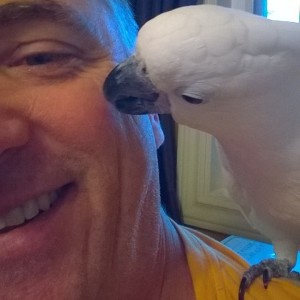Rolling ball sculpture is a fascinating, complex and relatively new art form. Currently, there are a number of outlets on the web from which one can mine information about it, but it is largely technical in nature. I have realized that the creators, the ones who breathe life into this wonderful form of kinetic expression, are often left in the shadows, information on them being provided only by a few scant “About Me” descriptions on web pages or random web posts. I have decided to do something about this lack of information, to shine some light on these wonderful creators, and in the process, to provide the world with a fuller view of the magnificent art of rolling ball sculpture.
To that end, I am pleased and excited to present you with the first in a series of interviews I will be publishing featuring highly talented rolling ball sculpture artists. Far more than simple “How’d you make that?” FAQs, these interviews will focus on each artist’s backgrounds, and their different abilities and experiences that have led them to this unique and captivating creative outlet. Yes, there will be technical information shared – I won’t go without missing that opportunity – but an equally valuable opportunity will be seized to present the artists and their art in as full a capacity as possible. The aim is to broaden the recognition and understanding of the artists and the art form itself. It’s a first of its kind literary and artistic project for rolling ball sculpture, and it’s going to be great stuff! There will be a new interview posted on the third Thursday of the month.
Our inaugural interview is with accomplished and skilled RBS artist Stephen Jendro. Stephen credits a childhood gift from an uncle with igniting his fascination with rolling ball sculpture. He has traveled the world, worked with rockets, owns 80 birds, and considers singer/songwriter Todd Snyder to be an important tool in the work shop. But how does this add up to amazing kinetic art? Read on to find out!

TH: Where are you from?
SJ: Carnation Washington, about 20 mi east of Seattle where Carnation sweetened condensed milk comes from. I was born in southern CA and then the family moved to New Zealand and then Australia when I was a kid. Then I came back to southern California. So I was educated in the British schooling system, but I’m an American.
TH: What were your big interests when you were younger?
SJ: Plastic train tracks when I was two. When I was four I got an Erector set. I remember building a Ferris wheel when I was four. I remember that once I realized the nuts went on the bolts, it was amazing. You could connect stuff! And then Lego, lots of Lego and slot car sets. Things with tracks and motors and kineticism, lots of slot car tracks. Later, a lot of skateboarding. When I think about all the skateboarding I did, I realize that I was the marble!
TH: Did you have any schooling in the arts?
SJ: No. A friend called me “autodidactic.” I got out of high school and went straight to work, and I’m self taught on everything.
TH: What is your day job?
SJ: I’ve been at Microsoft for 15 years as a web site manager and web site producer.
TH: When did you first discover rolling ball sculpture?
SJ: When I was ten my uncle brought home a brass rod rolling ball sculpture that I think he got in San Francisco. That was a good place for that kind of art in the 70s. It had one-inch steel balls, and I played with it way more than any normal child would play with it. And here we are forty years later, and I can still remember – I could build that thing from memory, and as a matter of fact, I might build that thing from memory yet.
TH: Do you know who built it?
SJ: No, I’ve tried and tried. If I had to guess I’d say it was a Stan Bennett. I do remember that it was brass or bronze rod, and it had a name on it, but it had little people – little weld-dots out of leftover pieces of rod, a blob for the head and blobs for the hands. They were just stuck on there. But I have no idea who really did it.
TH: What do you recall really drew you to that sculpture? Continue reading →


